CHEVROLET ASTRO CARGO VAN 1995 2.G Owners Manual
Manufacturer: CHEVROLET, Model Year: 1995, Model line: ASTRO CARGO VAN, Model: CHEVROLET ASTRO CARGO VAN 1995 2.GPages: 342, PDF Size: 17.57 MB
Page 171 of 342
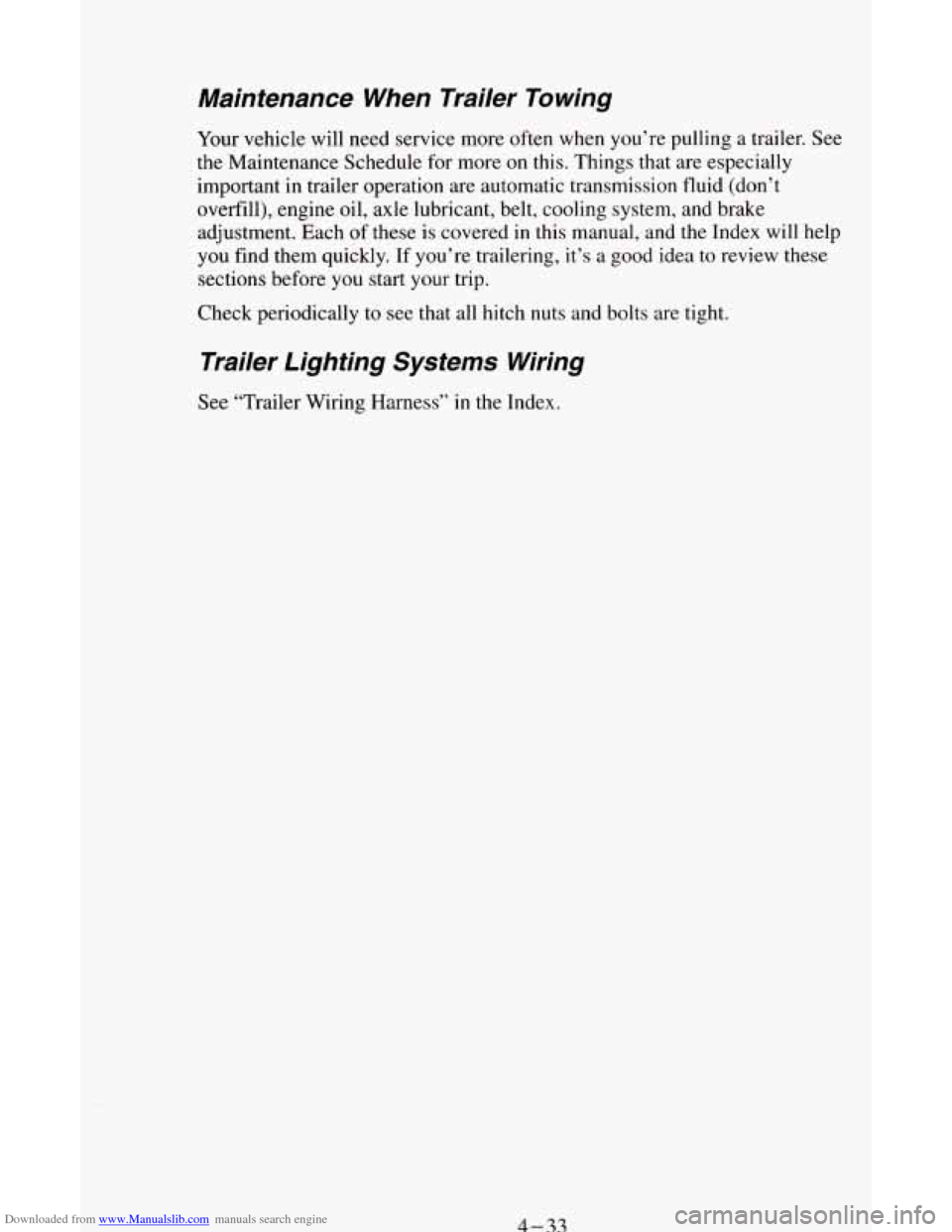
Downloaded from www.Manualslib.com manuals search engine Maintenance When Trailer Towing
Your vehicle will need service more often when you’re pulling a trailer. See
the Maintenance Schedule for more
on this. Things that are especially
important in trailer operation are automatic transmission fluid (don’t
overfill), engine oil, axle lubricant, belt, cooling system, and brake
adjustment. Each of these is covered in this manual, and the Index will help
you find them quickly. If you’re trailering, it’s a good idea to review these
sections before you start your trip.
Check periodically to see that all hitch nuts and bolts are tight.
Trailer Lighting Systems Wiring
See “Trailer Wiring Harness” in the Index.
4-33
Page 172 of 342
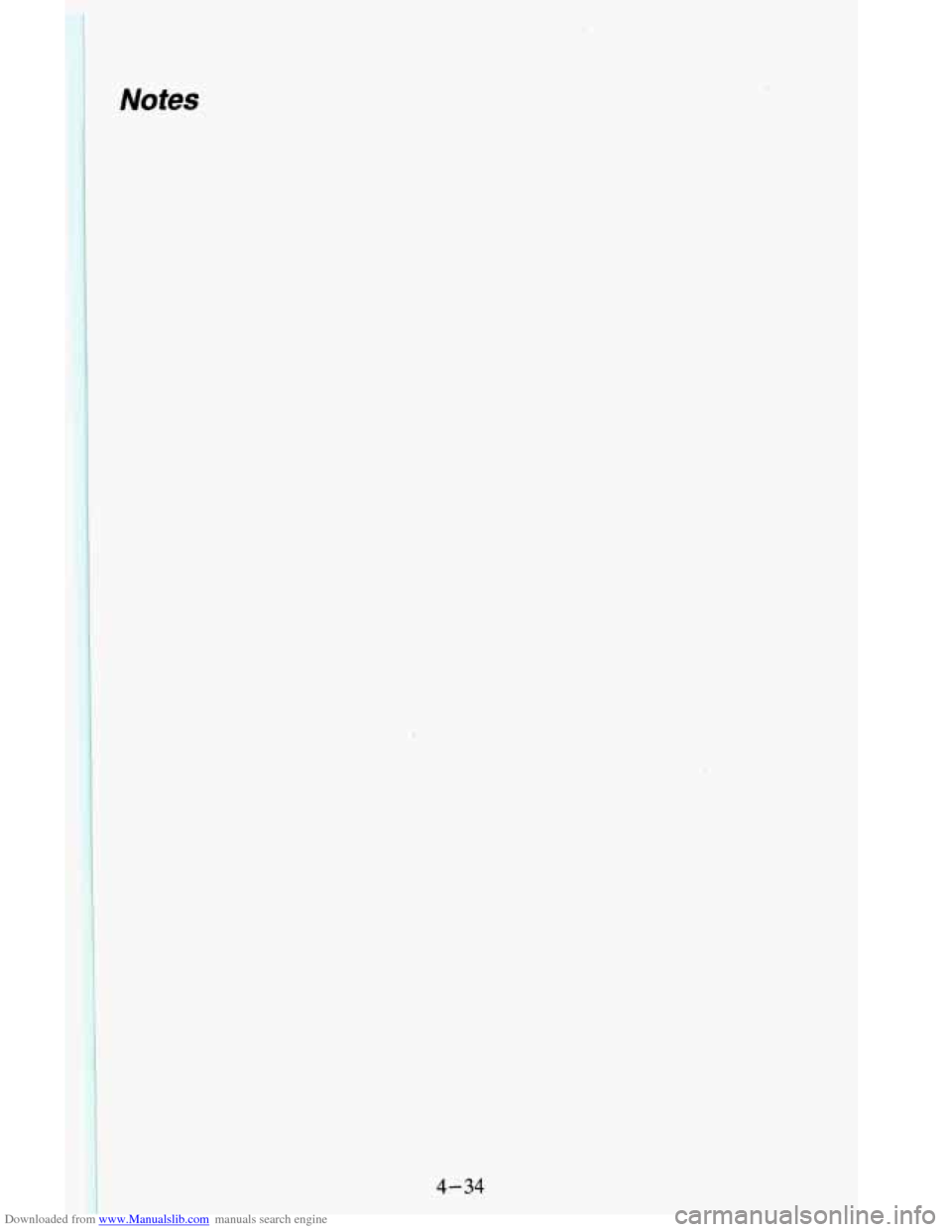
Downloaded from www.Manualslib.com manuals search engine Notes
4-34
Page 173 of 342
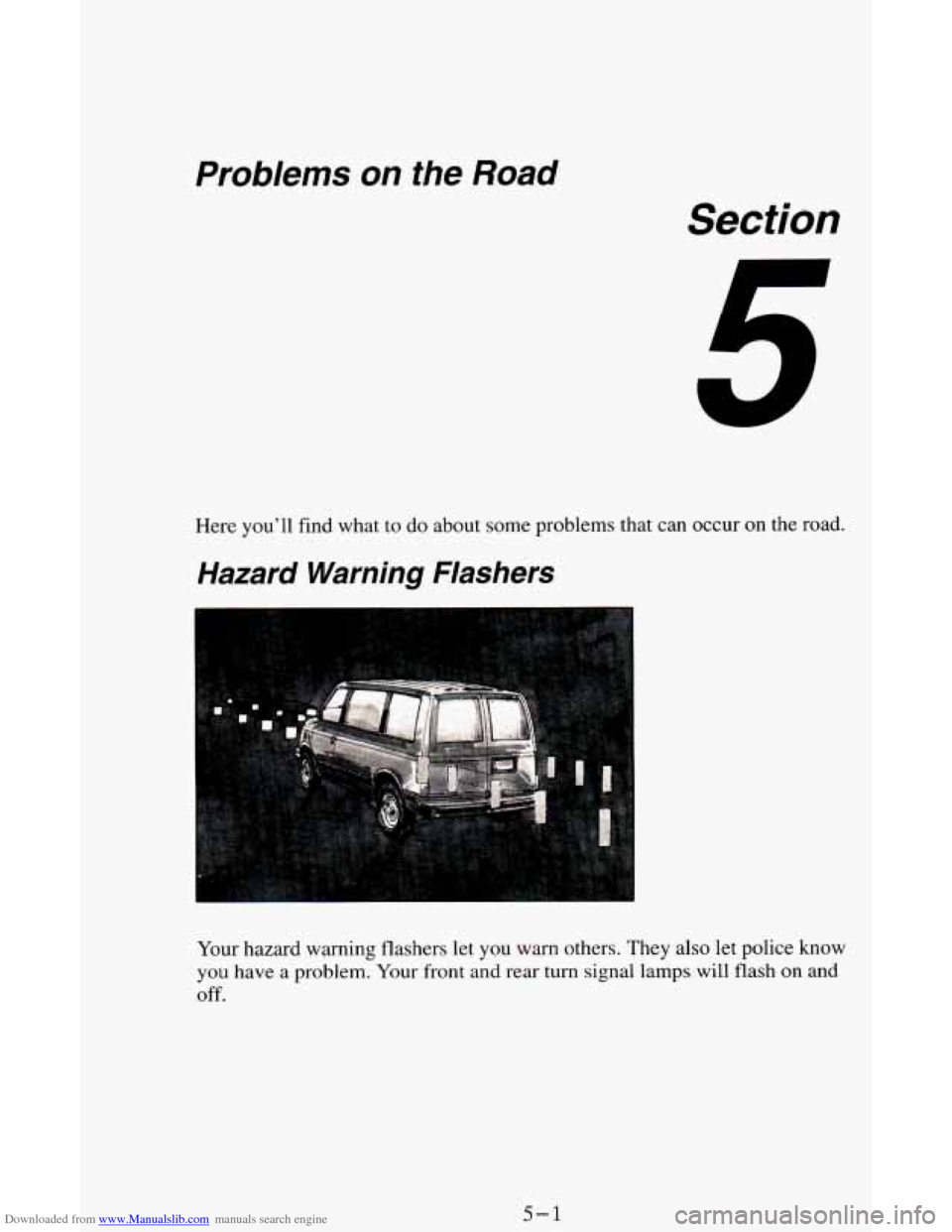
Downloaded from www.Manualslib.com manuals search engine Problems on the Road
Here you’ll find what to do about some problems that can occur on the road.
Hazard Warning Flashers
Your hazard warning flashers let you warn others. They also let police know
you have a problem. Your front and rear turn signal lamps will flash on and
off.
5-1
Page 174 of 342
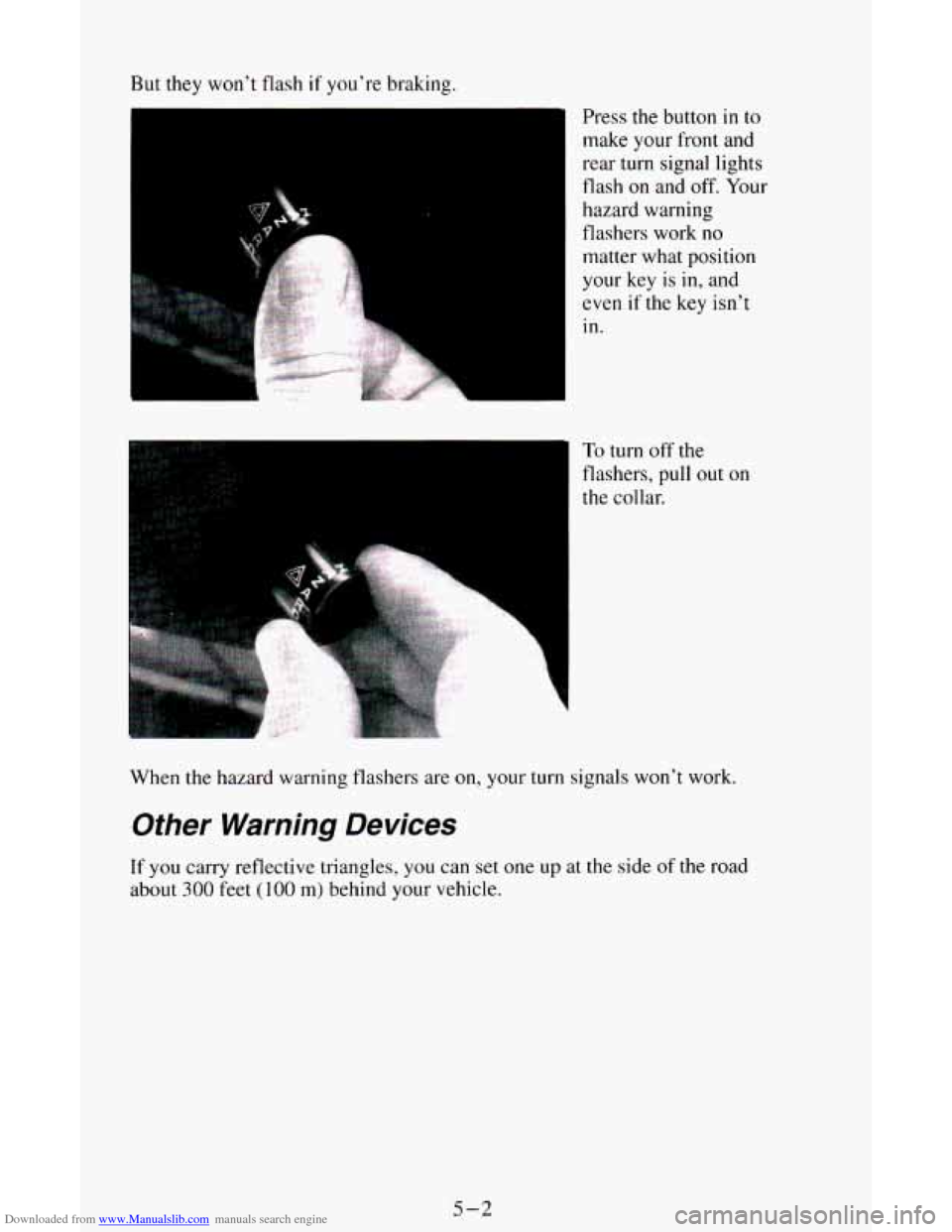
Downloaded from www.Manualslib.com manuals search engine But they won’t flash if you’re braking. Press the button
in to
make your front and
rear turn signal lights
flash
on and off. Your
hazard warning
flashers work no
matter what position
your key
is in, and
even
if the key isn’t
in.
To turn off the
flashers, pull out on
the collar.
When the hazard warning flashers are on, your turn signals
won’t work.
Other Warning Devices
If you carry reflective triangles, you can set one up at the side of the road
about
300 feet (100 m) behind your vehicle.
5-2
Page 175 of 342
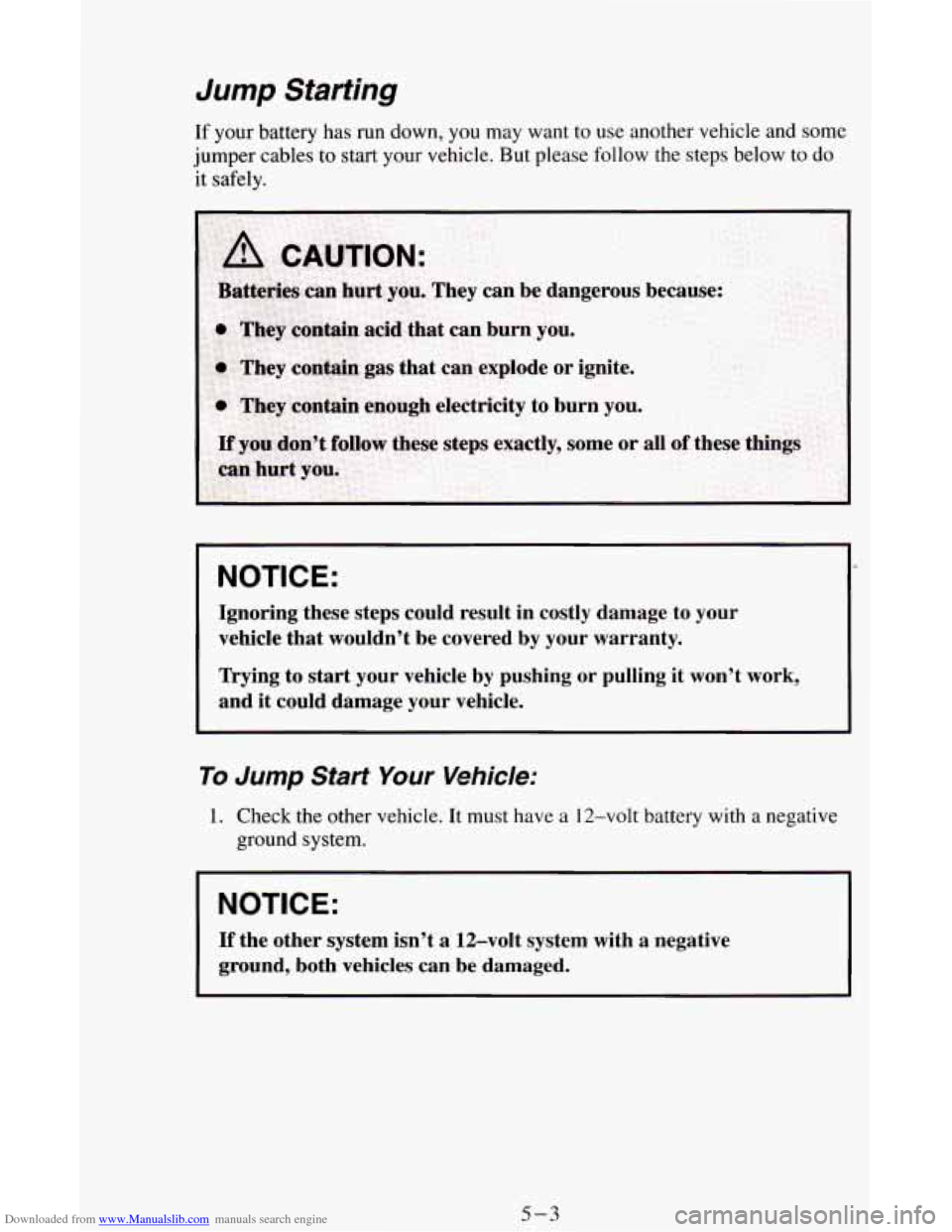
Downloaded from www.Manualslib.com manuals search engine Jump Starting
If your battery has run down, you may want to use another vehicle and some
jumper cables to start your vehicle. But please follow the steps below to do
it safely.
I NOTICE:
Ignoring these steps could result in costly damage to your
vehicle that wouldn’t be covered by your warranty.
Trying to start your vehicle by pushing or pulling it won’t work,
and it could damage your vehicle.
To Jump Start Your Vehicle:
1. Check the other vehicle. It must have a 12-volt battery with a negative
ground system.
r
~ ~~
NOTICE:
If the other system isn’t a 12-volt system with a negative
ground, both vehicles can be
damaged.
5-3
Page 176 of 342
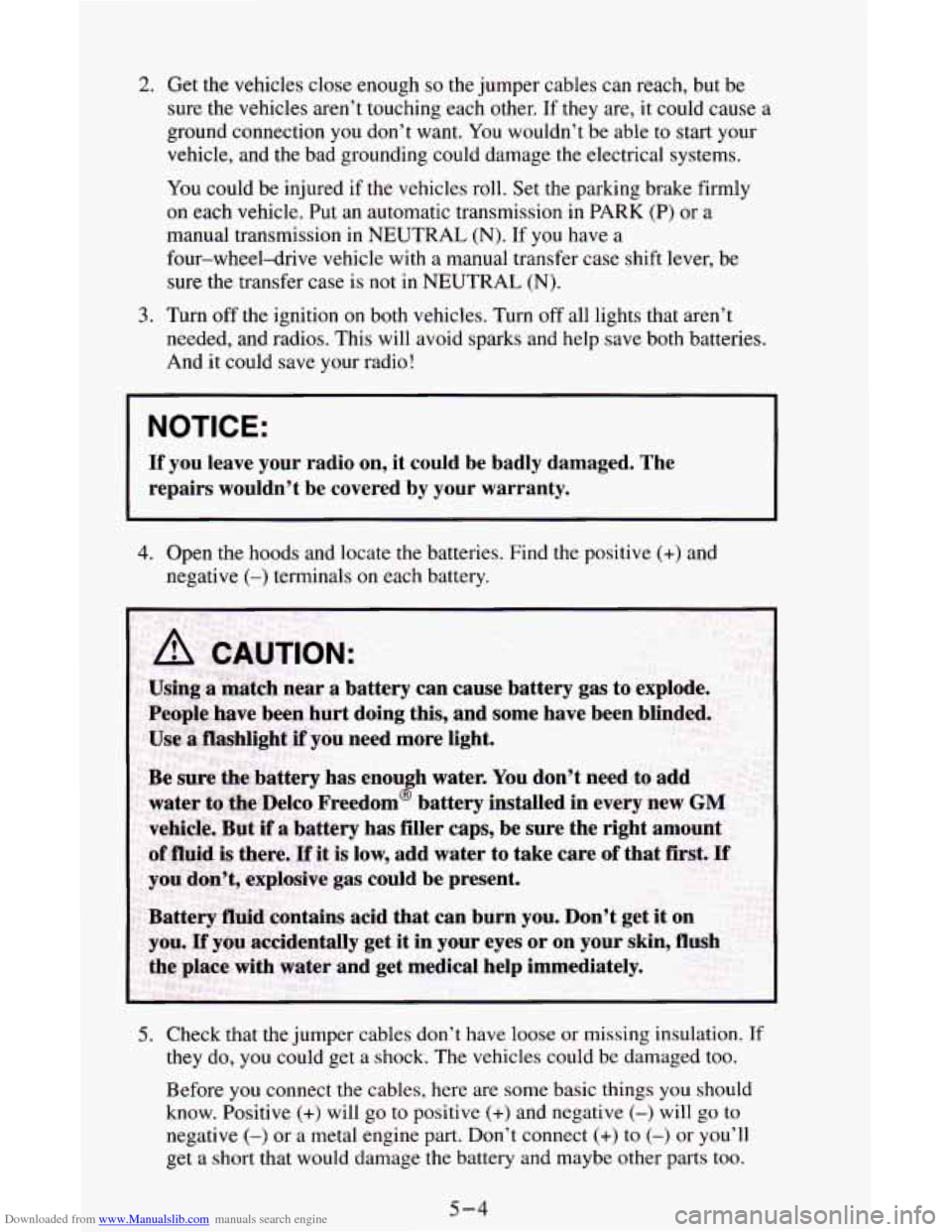
Downloaded from www.Manualslib.com manuals search engine 2. Get the vehicles close enough so the jumper cables can reach, but be
sure the vehicles aren’t touching each other.
If they are, it could cause a
ground connection you don’t want. You wouldn’t be able to start your
vehicle, and the bad grounding could damage the electrical systems.
You could be injured if the vehicles roll. Set the parking brake firmly
on each vehicle. Put an automatic transmission in PARK
(P) or a
manual transmission in NEUTRAL (N).
If you have a
four-wheel-drive vehicle with
a manual transfer case shift lever, be
sure the transfer case is
not in NEUTRAL (N).
3. Turn off the ignition on both vehicles. Turn off all lights that aren’t
needed, and radios. This will avoid sparks and help save both batteries.
And it could save your radio!
- ~-
NOTICE:
If you leave your radio on, it could be badly damaged. The
repairs wouldn’t be covered by your warranty.
4. Open the hoods and locate the batteries. Find the positive (+) and
negative
(-) terminals on each battery.
5. Check that the jumper cables don’t have loose or missing insulation. If
they do, you could get a shock. The vehicles could be damaged too.
Before
you connect the cables, here are some basic things you should
know. Positive
(+> will go to positive (+) and negative (-) will go to
negative
(-1 or a metal engine part. Don’t connect (+) to (-) or you’ll
get a short that would damage the battery and maybe other parts too.
5-4
Page 177 of 342
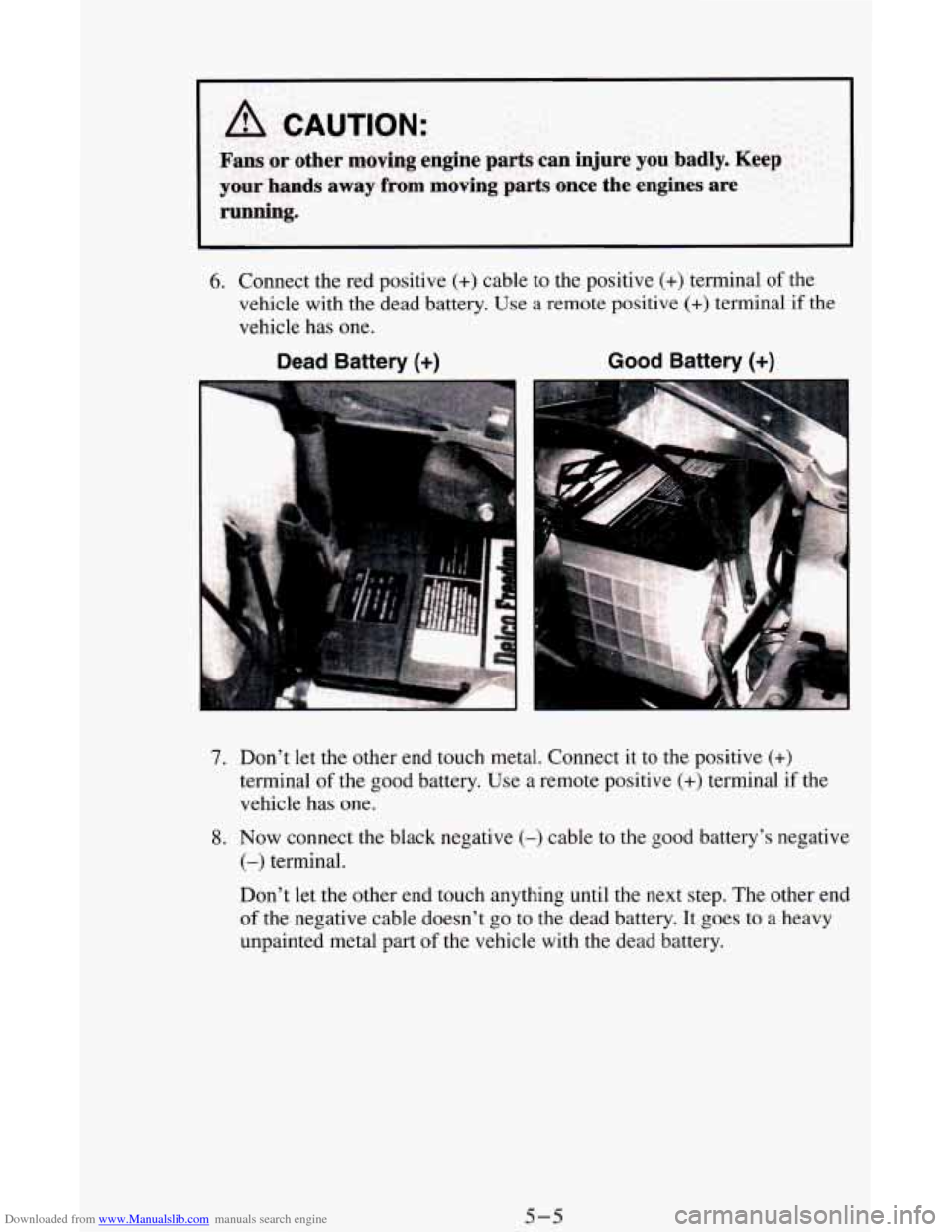
Downloaded from www.Manualslib.com manuals search engine A CAUTION:
Fans or other moving engine parts can injure you badly. Keep
your hands away from moving parts once
the engines are
running.
6. Connect the red positive (+) cable to the positive (+) terminal of the
vehicle with the dead battery. Use a remote positive
(+) terminal if the
vehicle has one.
Dead Battery (+) Good Battery (+)
7. Don’t let the other end touch metal. Connect it to the positive (+)
terminal of the good battery. Use a remote positive (+) terminal if the
vehicle has one.
8. Now connect the black negative (-) cable to the good battery’s negative
(-) terminal.
Don’t let the other end touch anything until the next step. The other end
of the negative cable doesn’t go to the dead battery. It goes to a heavy
unpainted metal
part of the vehicle with the dead battery.
5-5
Page 178 of 342
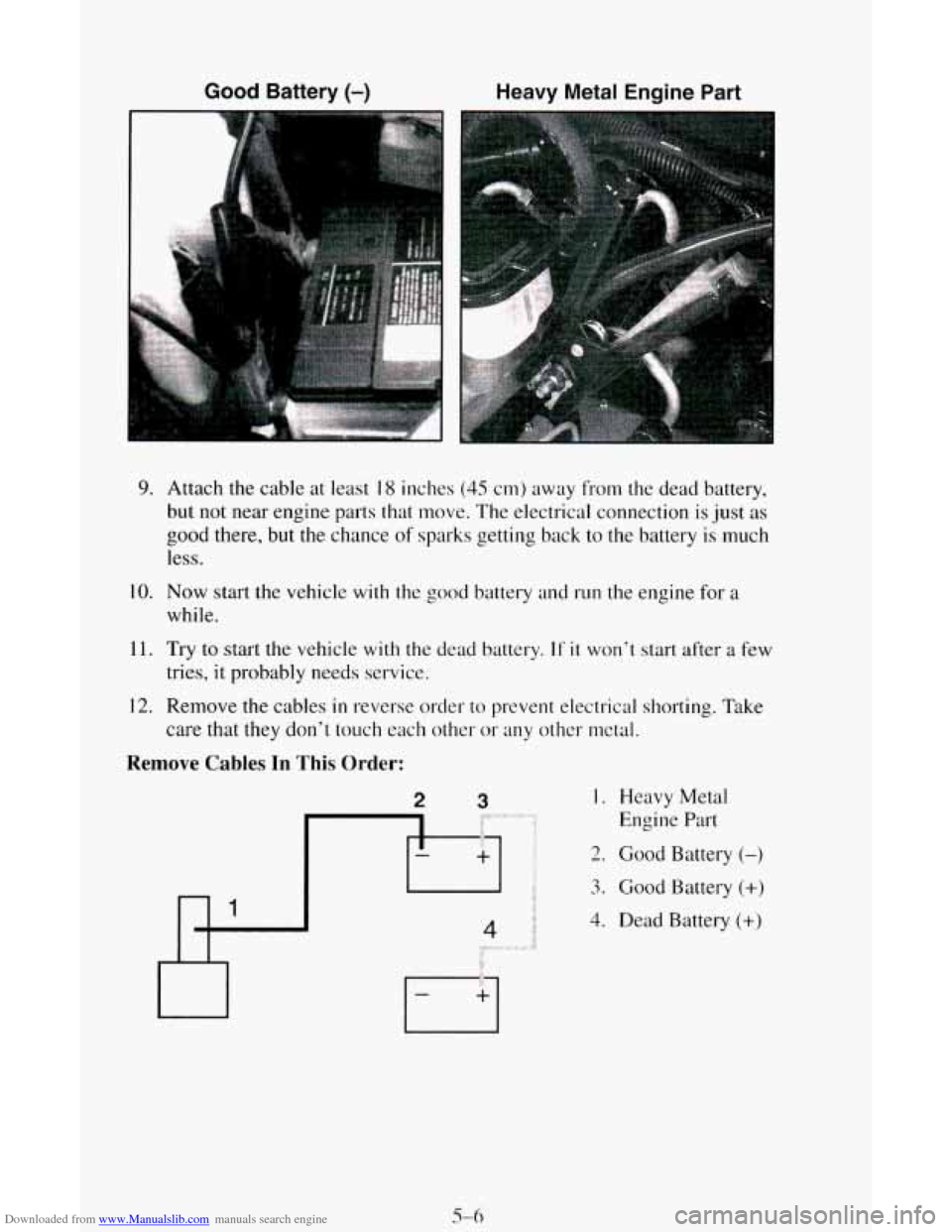
Downloaded from www.Manualslib.com manuals search engine Good Battery (-) Heavy Metal Engine Part
9. Attach the cable at least 18 inches (45 cm) away from the dead battery,
but not near engine parts that move. The electrical connection
is just as
good there, but the chance of sparks getting back to the battery is much
less.
10. Now start the vehicle with the good battery and r~~n the engine for a
while.
11. Try to start the vehicle with the dead battery. If it won’t start after a few
tries,
it probably needs service.
12. Remove the cables in reverse order to prevent electrical shorting. Take
care that they don’t touch each other
or any other mctal.
Remove Cables In This Order:
I. Heavy Metal
Engine Part
2. Good Battery (-)
3. Good Battery (+)
4. Dead Battery (+)
Page 179 of 342
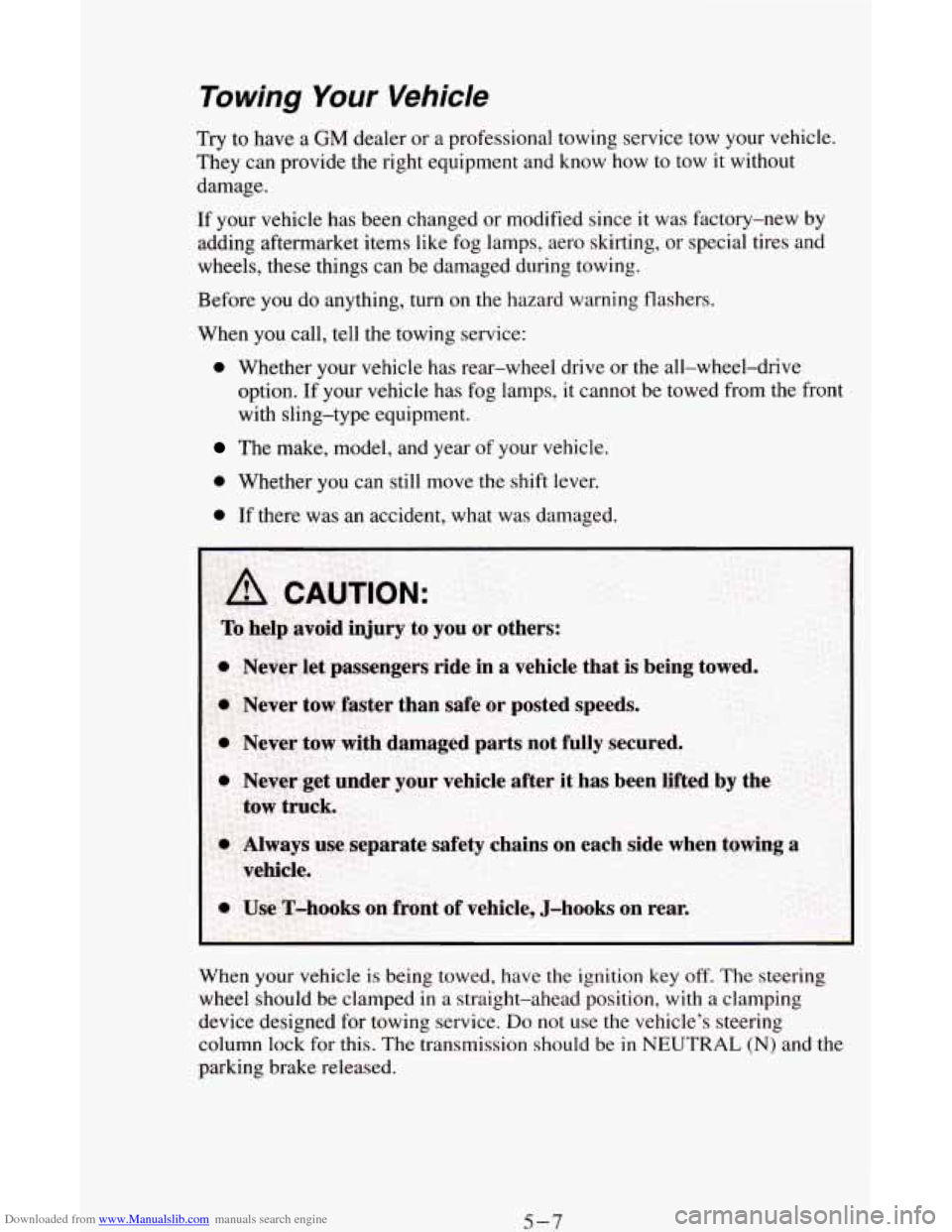
Downloaded from www.Manualslib.com manuals search engine Towing Your Vehicle
Try to have a GM dealer or a professional towing service tow your vehicle.
They can provide the right equipment and know how to tow
it without
damage.
If your vehicle has been changed
or modified since it was factory-new by
adding aftermarket items like fog lamps, aero skirting, or special tires and
wheels, these things can be damaged during towing.
Before
you do anything, turn on the hazard warning flashers.
When
you call, tell the towing service:
0 Whether your vehicle has rear-wheel drive or the all-wheel-drive
option. If your vehicle has fog lamps, it cannot be towed from the front
with sling-type equipment.
The make, model, and year of your vehicle.
0 Whether you can still move the shift lever.
0 If there was an accident, what was damaged.
When your vehicle
is being towed, have the ignition key off. The steering
wheel should be clamped in a straight-ahead position, with
a clamping
device designed for towing service.
Do not use the vehicle’s steering
column lock for this.
The transmission should be in NEUTRAL (N) and the
parking brake released.
5-7
Page 180 of 342
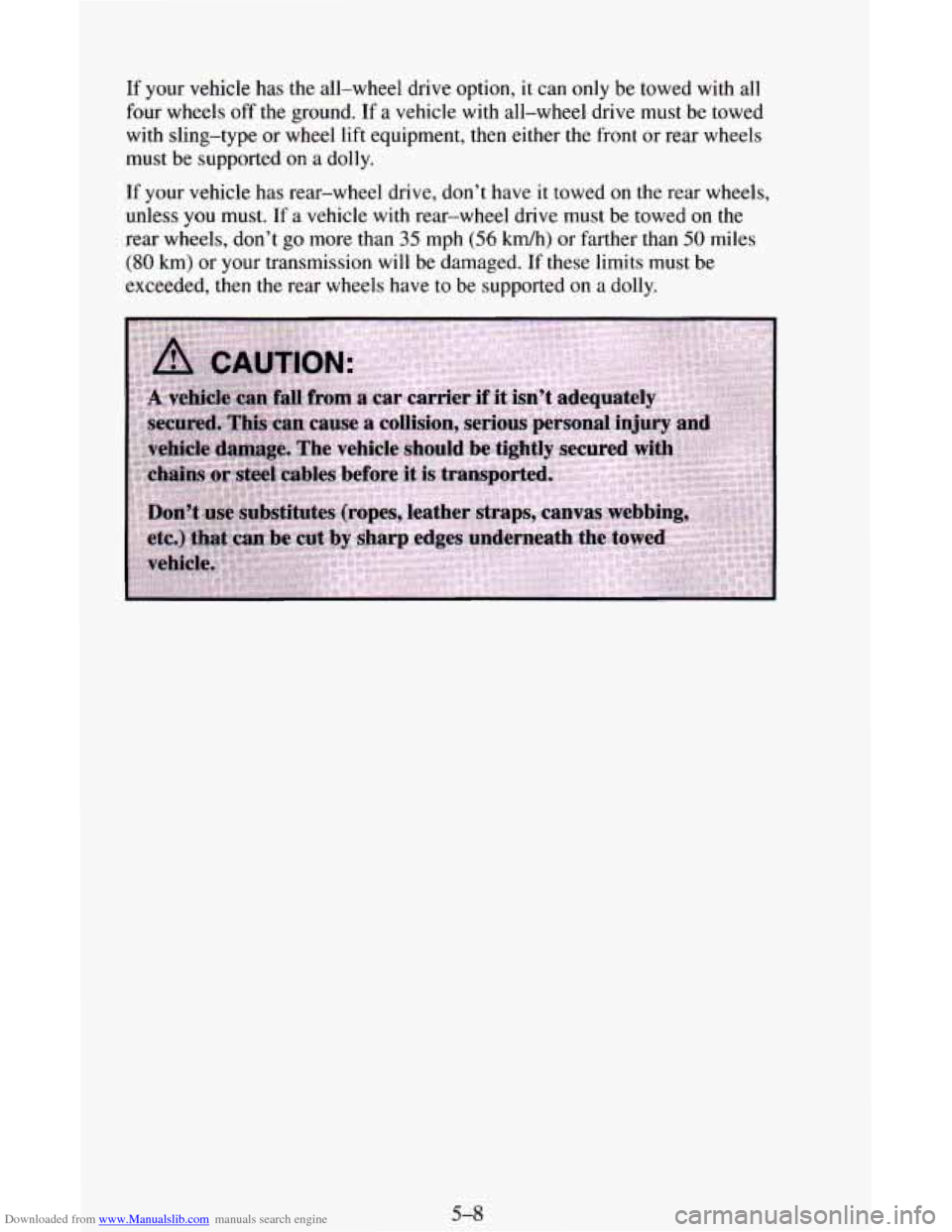
Downloaded from www.Manualslib.com manuals search engine If your vehicle has the all-wheel drive option, it can only be towed with all
four wheels off the ground. If a vehicle with all-wheel drive must be towed
with sling-type or wheel lift equipment, then either the front
or rear wheels
must be supported
on a dolly.
If your vehicle has rear-wheel drive, don’t have it towed on the rear wheels,
unless
you must. If a vehicle with rear-wheel drive must be towed on the
rear wheels, don’t go more than
35 mph (54 km/h) or farther than 50 miles
(80 km) or your transmission will be damaged. If these limits must be
exceeded, then the rear wheels have
to be supported on a dolly.
5-8